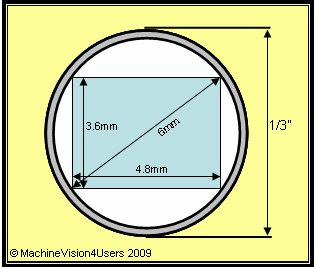
If you’ve ever tried to use one of the many lens calculator programs around (see my posting, “lens calculators,”) you’ll be aware that they expect you to know the size of the sensor in your camera. This can be obtained from the camera specifications. It cannot however be derived from a knowledge of the pixel size.
There are two issues. First, the quoted sensor size is a diagonal, not a width or height. But do not go thinking that by taking the pixel size and number of pixels in ‘X’ and ‘Y’ and invoking Pythagoras you can determine the diagonal. While that will give you the actual diagonal dimension of the sensor, it will not tell you the sensor size.
That is based on the outside diameter of the tubes used in the old Vidicon television cameras. They made these in 1”, 2/3” and ½” sizes to obtain an image with a 4:3 aspect ratio. So, as my little diagram should explain, a 1/3” sensor has a diagonal of 6mm, which is just under ¼”. (There’s an excellent discussion of this buried deep in the “Technical Notes” section of the JAI web site – look for the paper titled “Video 101 Tutorial”.)
And why does all this matter? That’s a topic for a later post.





No comments:
Post a Comment